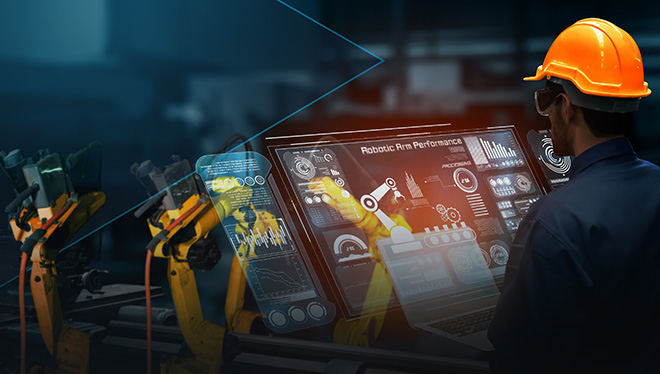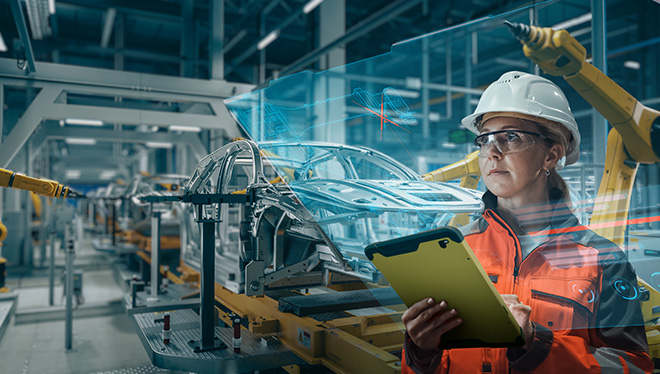

SIGNALS+ NEWSLETTER SUBSCRIPTION
Stay updated and leverage Signals+ latest insights, information and ideas on Connectivity, Digital Health, Electrification, and Smart Industry.
Thank you for subscribing to ADI Signals+. A confirmation email has been sent to your inbox.
You'll soon receive timely updates on all the breakthrough technologies impacting human lives across the globe. Enjoy!
CloseFUELING THE DIGITAL FACTORY WITH DATA TO UNLOCK EFFICIENCIES (Sustainability
Series #5)
This is the fifth article in a series that aims to illuminate how innovative technological platforms and software solutions are enabling climate tech and invite dialogue with others on the future of energy and sustainability. See here for article 4, "Manage, Convert, and Store: Transitioning to a Decentralized Energy Grid".
Today, managers of industrial buildings and factories face a pivotal moment: how do they strive to achieve ambitious energy-efficiency goals within technically demanding facilities while energy consumption continues to grow? The success of a factory manager in meeting this challenge depends on how they address this question—which investments will increase energy efficiency, reduce emissions, and enhance competitiveness?
For many, the key lies in accessing new data streams and insights from the factory floor to enhance operational understanding and achieve real-time production optimizations.
Overall energy efficiency (not just in factories) could provide more than 40% of the emission reductions required by 2040 to be in line with the Paris Agreement.2 On the flip side, each unit of energy used for heating, cooling, or powering a factory will need to deliver more energy than it does today if we are to achieve net-zero by 2050.3 There is a need for understanding where energy is wasted in existing production flows and the identification of where productivity gains can be captured.
However, lack of real-time measurements hinders existing factory upgrades, and the identification of asset-level and product flow information is needed to keenly identify these opportunities for efficiency improvements.
Fortunately, factory connectivity and digitalization are rapidly addressing this challenge by capturing real-time data at the asset level. Improved visibility into factory performance can help remove bottlenecks, extend asset lifetimes, and reduce raw material usage—helping reduce energy consumption while helping increase utilization.

“Data is the fuel of the digital factory. Factories are moving toward software-defined automation, fuelled with increased computational power, modern high bandwidth connectivity, and flexibility, by decoupling the control functions from the compute host. This increases adaptability, and operational efficiency of factories, both in terms of additional production output and optimized energy usage for a given production level”.Aurelien Le Sant
CTO—SVP Innovation & Technology Industrial Automation | Schneider Electric
WHAT IS A DIGITAL, CONNECTED FACTORY?
A digital factory relies on data and consists of three key facets: connectivity, advanced automation, and sensorization of the factory floor. By leveraging data and sensor insights, decision-making is informed and automation and robotics are deployed to streamline operations. This results in actionable insights that optimize operations and help reduce energy consumption and waste.
HELP INCREASE ENERGY EFFICIENCY WITH THE POWER OF 3: CONNECT, CONTROL, INTERPRET

CONNECT: The Hybrid Factory Network
Manufacturers require enhanced connectivity to access and analyze data across the factory floor, enabling them to unlock capacity with the goal of reducing energy consumption. The ability to transport, analyze, and merge this data with existing information streams is paramount. This is effectively the first element of digitization—adding real-time and non-real-time connectivity to access operational insights.

Unfortunately, legacy fieldbus technology in factory networks hinders bandwidth, time sensitivity, and wireless device support. Upgrading to a unified factory network with seamless device connectivity and direct IP addressability enables near real-time communication, independent node configuration, and scalable sharing of operational insights. Enhanced wired and wireless connectivity, with increased security and ease of deployment, allows companies to leverage the wealth of data generated in factory devices for potential productivity and energy efficiency gains.
CONTROL: Creating Flexible, Automated Control
There is increasing demand across the manufacturing sector for flexibility in the face of wanting to retain performance stability, consistency of output, and availability/uptime. Upgraded connectivity networks enable real-time data analysis, flexible manufacturing, and advanced automation, allowing factories to efficiently produce personalized products and smaller batch sizes by quickly adapting to customer demand and specifications.
With configurable, flexible, and precise control systems, factories can optimize energy usage by changing production flows with minimal downtime. Precise equipment control can lead to improved operation, increased output, reduced energy consumption, and minimized waste.

Programmable logic controllers (PLC) are the central control system in modern factories and I/O cards are the workhorse controlling everything from motors and limit switches to pumps and level meters. New software-configurable, universal I/O solutions provide flexibility to easily change factory setups improving adaptability and enabling faster commissioning and reconfiguration.
Agile manufacturing is achieved through nimble control systems and advanced robotic systems that adapt to worker positioning in real time. Mobile robots with innovative vision sensing technology and sophisticated algorithms enable efficient worker/human collaboration ensuring continuous robot functioning. This can enhance safer workspaces for humans while enhancing the efficiency of operations.
What’s more, pairing an industrial motor with a variable speed drive enables accurate torque, velocity, and position control, as outlined in a previous Signals+ Sustainability Series article.
INTERPRET: Sensing and Interpreting for New Insights

To unlock the potential of digital factories, the network edge (or Intelligent Edge as ADI refers to it) plays a crucial role in generating new data from assets. By deploying advanced sensors on existing assets, valuable information is obtained for maintenance schedules, workflow routing, and more. Smarter, smaller, and more sophisticated sensors are revolutionizing industrial automation, enabling real-time identification of potential issues like product defects or asset health deterioration.
Complementing sensors with increased edge intelligence enables faster, more energy-efficient, localized decision-making, helping unlock new levels of operational efficiency. Sensor fusion and Intelligent Edge AI algorithms further enhance performance monitoring and optimization, while helping detect deviations.
(2021-22)4
LIGHTHOUSE FACTORIES: BRINGING THE PROMISE OF DIGITAL TRANSFORMATION TO LIFE
The Global Lighthouse Network (GLN)—a World Economic Forum initiative in collaboration with McKinsey—is comprised of leading manufacturers who are committed to adopting digitalization and industry 4.0 technologies in their factories to achieve both operational excellence and more sustainable practices. Through a combination of developing the skills of their workforces, sharpening their strategy, and ensuring focus on scalable execution, results have been impressive across the GLN. Achievements for member factories include:
- Reductions in resource use of more than 1/3 while tripling factory throughput
- Improving efficiency by more than 10% and cutting greenhouse gas emissions in half while improving quality
- Raising quality by 300% while reducing costs by more than 20% and emissions by more than a quarter
- Increasing customer satisfaction and employee engagement while reducing material losses by more than 75%5
A SUCCESSFUL DIGITAL FACTORY STARTS WITH ECOSYSTEM CONNECTIONS
Hundreds of thousands of factories in operation today have the potential to be optimized by digitizing through the power of 3: Connect, Control, and Interpret. Digitizing can be a transformational element as manufacturers look to achieve energy efficiency goals and improve productivity.
Ultimately, the success of connected, digitized factory hinges on manufacturers forming strong bonds with ecosystem players who deliver advanced technologies that produce trusted, reliable data from the Intelligent Edge. The result of this collaboration can lead to a factory environment that can reduce energy consumption and waste, limit downtime, and enhance productivity.

References
1 “Industrial Sector Energy Consumption.” EIA.gov.
2 “Market Report Series: Energy Efficiency 2018.” IEA.
3 “Net Zero by 2050 Hinges on a Global Push to Increase Energy Efficiency.” IEA.
4 “Senseye Predictive Maintenance: The True Cost of Downtime 2022.” Siemens.
5 “The Scaling Imperative for Industry 4.0.” McKinsey.




 Close Details
Close Details


